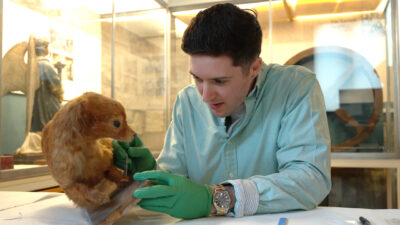Somerville is delighted that our Fulford Junior Research Fellow Dr Lachie Scarsbrook is a key author of a new study which reveals how humans and dogs spread across Eurasia together.

Somerville JRF Dr Lachie Scarsbrook
Dogs have been part of human societies across Eurasia for at least 20,000 years. This genomic study, published in Science, shows that over the last 10,000 years, the spread of new cultures across Eurasia was often associated with the spread of specific dog populations. The study has been featured in Time Magazine, and on the BBC news (alongside another article from Science, suggesting the domestication of dogs began much earlier than previously thought).
The study’s international team was led by paleogeneticist Laurent Frantz and included scientists from LMU and Kunming and Lanzhou in China, as well as the University of Oxford. The team sequenced and analysed the genomes of 17 ancient dogs from Siberia, East Asia, and the Central Asian Steppe – including, for the first time, specimens from China.
Important cultural changes occurred in these regions over the past 10,000 years, driven by the dispersal of hunter-gatherers, farmers, and pastoralists. The specimens came from archaeological sites between 9,700 and 870 years old.
By comparing these ancient dog genomes with human ones, the study revealed a striking concordance between genetic shifts in both species across time and space, most notably during periods of population turnover.

Lachie on a recent sampling trip to Abergavenny Museum, with “Whiskey”, the last surviving example of a turnspit
This link is especially evident during China’s transformative Early Bronze Age (~4,000 years ago), which saw the introduction of metalworking. The research shows that the people from the Eurasian Steppe, who first introduced this transformative technology to Western China, also brought their dogs with them.
This pattern of humans and dogs moving across regions together extends back far beyond the Bronze Age. The research traces signals of co-movement back at least 11,000 years, when hunter-gatherers in northern Eurasia were exchanging dogs closely related to today’s Siberian Huskies.
“Traces of these major cultural shifts can be teased out of the genomes of ancient dogs,” says Somerville JRF Dr. Lachie Scarsbrook. “Our results highlight the deeply rooted cultural importance of dogs. Instead of just adopting local populations, people have maintained a distinct sense of ownership towards their own dogs for at least the past 11,000 years.”
“This tight link between human and dog genetics shows that dogs were an integral part of society, whether you were a hunter-gatherer in the Arctic Circle 10,000 years ago or a metalworker in an early Chinese city,” says Prof. Laurent Frantz. “It’s an amazing, enduring partnership and shows the sheer flexibility of the role dogs can play in our societies, far more than with any other domestic species.”